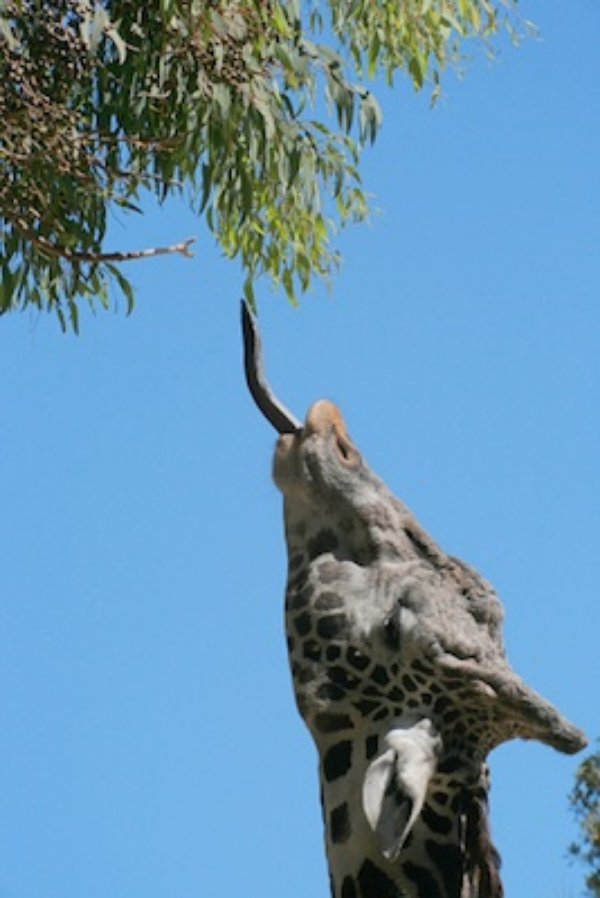Some animals eat meat.
Some animals eat plants.
Some animals eat both meat and plants.
Animals have different teeth and stomachs to help them eat their food.
Animals have different ways of digesting the food they eat. Their teeth and digestive systems are adapted to their diet.
Herbivores are animals that eat plants.
Giraffes use their long tongues to get to hard to reach leaves. Photo©Getty Images
Many herbivores do not have upper incisors (the teeth on the top jaw in the very front that cut food), and they cut the plants with their lips instead.
However, all herbivores need their molars (the big flat teeth at the back of the mouth) for grinding the mouthfuls of food. A herbivore’s molars are big and have ridges for better grinding.
Herbivore skulls have spaces for big muscles to be attached to move their jaws for so much chewing. Plants, particularly grasses, are very hard to digest.
Fermentation
Animals that eat plants need to have a particular bacteria inside their bodies to help break down the tough plants so that they release nutrients.
This process is called fermentation. Herbivores do this in either of two ways: they are ruminant or non-ruminant.
Some herbivores are ruminants (say room-in-unt).
Yaks are ruminants. i Photo©Getty Images
Ruminants have four parts to their stomachs:
Food goes to the first parts, called the rumen (say room-in) and the reticulum (say reh-tick-you-lum), where some digestion takes place.
Later on this partly digested food, now called cud, is brought back up into the animal’s mouth to be chewed more. This is called chewing the cud.
The cud is then swallowed and goes into the third and fourth parts of the stomach, called the omasum (say oh-ma-sm) and abomasum (say uh-boe-ma-sm), where digestion continues.
Ruminants do not need to drink very much water because there is moisture in and on the plants they eat.
All ruminants have stomachs with 4 parts. © Getty Images
Ruminants include giraffes, camels, goats, cows and some antelopes.
Zebras are non ruminants. Photo©Getty Images
Some herbivores are non-ruminants.
The fermentation takes place further down their digestive system so that by the time the tough walls of the plant cells are broken down, the food has already gone past the part of the gut that absorbs most nutrients.
This means that the animals have to eat huge quantities in order to get enough nutrition for their bodies. Non-ruminants pass quite a lot of undigested food out of their bodies. They have to spend about three quarters of the day feeding.
For grazers, this means a great deal of time where they are at greater risk of being attacked by predators. They have long heads, with eyes located high on the head and at the sides so they can be on the lookout for predators while they graze.
Non ruminants include horses, zebras, hippopotomus, rhinoceros, gorillas.
Carnivores are animals that eat meat.
Carnivores include lions, jaguars, leopards, and cheetahs Photo©Getty Images
Carnivores get more nutrients from their food, so they do not need to spend as much time eating as herbivores do. Their digestive system is shorter than that of herbivores for the same reason. Because of the amount of nutrition they get, carnivores can go for several days without food.
Carnivore’s teeth are different from herbivore’s because of the different food.
Carnivores need long canine teeth (the teeth at the corners of the mouth) so they can grip and kill prey quickly. Their incisors strip flesh from bones. They don’t need molars for grinding food, so instead they have teeth that slice meat – these are called carnassial teeth, not molars. Carnivores have a shorter jaw than herbivores because that helps give them a powerful bite.
Carnivores include cheetahs, lions, leopards, tigers and jaguars.
Omnivores include ostriches, emus, most bears, sloths, chimpanzees and gibbons. Photo©Getty Images
Omnivores are animals that eat both meat and plants as part of their regular diet.
Their digestive system is similar to that of carnivores.
Read more about omnivores
https://www.animalwised.com/omnivorous-animals-228.html







